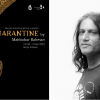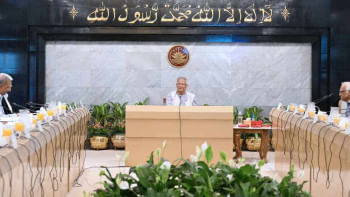‘Monon Khonon’: Unravelling the complex threads of material culture

Wakilur Rahman's solo exhibition, "Monon Khonon", currently on display at Bengal Shilpalay in Dhanmondi, offers an evocative exploration of material culture through the lens of visual art. By merging local elements with a global contemporary perspective, Rahman's work speaks to the unique relationship between the people of the delta region and their environment. His art forms a bridge between the ancient and the modern, the local and the universal.

The people of the delta region, with their unique way of life, deep-rooted philosophy, rich language, and soulful music, mould together a distinct and ever-evolving culture. In his pursuit to capture and map these intricate characteristics, the artist thus turned to the very elements that define this landscape.

His experimentation delves into three core components—the region's diverse topography, its indigenous materials, and the innate techniques and wisdom passed down through its generations. Wakilur Rahman explored these facets by drawing inspiration from the fluidity of water, the malleability of clay, the symbolism of boats, and the power of language to craft his artistic narrative.

The vast expanse of Bengal's waterways, the soaked earth, and the sweeping winds of the plains reflect a diverse yet profound natural world, deeply influencing the tangible expressions of our local creativity. While these cultural manifestations may seem fragmented, elusive, and resistant to easy interpretation, they conceal rich treasures within their many layers. The exhibition endeavours to unravel these complex threads of our material culture, digging into the essence of the spiritual and material embodiment of the people who inhabit this land.

"Monon Khonon", which translates to "Unearthing the Archaic," does not just present visual art; it presents a journey—an excavation of the mind and soul. The artist's approach is both methodical and intuitive, reflecting a deep respect for the materials he uses and the stories they tell. His works, which include nine installations based on wood, aluminium, iron, and terracotta, are not just objects of art but repositories of memory, history, and identity. These materials, chosen for their durability and connection to the earth, mirror the resilience of the delta people and their ability to adapt to the changing environment.

One of the most striking aspects of this exhibition is the artist's ability to make the local globally relevant. In a world where cultures are often homogenized through globalisation, Rahman's art highlights the power of local identity. His use of indigenous materials and techniques, combined with contemporary forms and ideas, creates a dialogue between the past and the present. This dialogue is particularly important in today's world, where the preservation of cultural identity is increasingly seen as a form of resistance against the forces of globalisation.

Wakilur Rahman works in various mediums of visual art, including painting, printmaking, sculpture, and installations. He graduated from the Faculty of Fine Arts, University of Dhaka, and earned an MFA from the Central Academy of Fine Arts, Beijing. For nearly four decades, he has been working internationally, while dividing his time between Dhaka and Berlin. Presently, he is serving as the curator of Kalakendra.

The "Monon Khonon" art exhibition will be on display at Bengal Shilpalay in Dhanmondi until September 14.

 For all latest news, follow The Daily Star's Google News channel.
For all latest news, follow The Daily Star's Google News channel. 








Comments